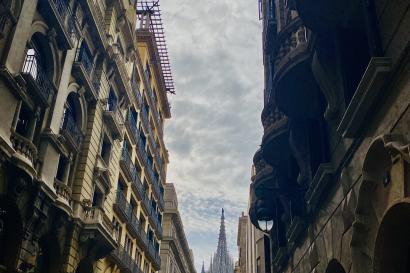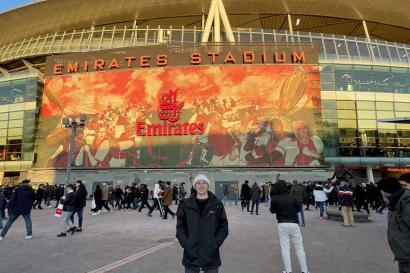
The Alhambra. Gushing streams of tangled etches cascade down curling arches. Firm, blocked pillars hoist up a labyrinth across the ceiling. Smooth marble, sets of twin trees, and gentle rays of sun all coalesce around a resplendent circle where a brave pride of jungle kings guard the bubbling fountain in the center of the palace that has drawn so many so near. Scrupulous eyes are drawn to a poem inscribed on the basin of the font:
“Hard and soft are so close,
that it would be hard to distinguish
liquid and solid, marble and water. Which one is running?
Don’t you see how water overflows the borders
and the warned drains are here against it?
They are like the lover who in vain
tries to hide his tears from his beloved.”
The Court of Lions inside the famous Muslim fort in Granada is one of the most magnificent architectural designs in history, a design I stared at for hours upon hours, not from inside its fortified walls, but from pictures on a computer screen while collecting research for a paper about Islamic art and architecture.
Visits to the most profitable building in Spain cannot, apparently, be planned the week prior. Tickets to the inner palaces sell out at least two months in advance. Third-party sellers increase the price sixfold, but even they have trouble keeping stock available. So when I went to the Alhambra, I went to the outside of the Alhambra. I walked through its weathered streets, below its behemoth walls, and across its crowded, asphalt parking lots. I stood among the rank and file, outside, unable to look in, commiserating with the centuries of fellow peasants who were only able to glimpse a snippet of its beauty.
Disgruntled and grumbling about the monetization of parochial historical vestiges, I walk and read my map, hoping to salvage some of the day. I walk. And I walk. 13.7 miles according to the Apple health app. I walk through cagey, slanted alleyways, across roads stitched with plump, wet brick, past souvenir shops and owners with glazed-over faces, dead stares that’ve given up peddling, sitting instead with head on hand, surrounded by an abundant supply of chic, octagonal, rainbow-painted, glass chess-boards. Older, bulging women meander around the sites most inundated with tourists, waving supposedly free stems of potent lavender in the faces of soft-smiling Americans, offering to read their spirit through their palms, then demanding a coin for not turning away soon enough.
I hike up, stopping briefly every hundred yards or so to watch how the fading light plays with the shining rooftops and slices between humble steeples. The cramped streets fade into a path of dust and a steep hillside of patchy shrubs, all stuck somewhere between green and grey. From the top emerges the prize that had been stolen from me in the morning hours.
Like a diving board hung above a tranquil pool, one rectangular strip of a rolling mountain range juts into the city that carpets the low, flat valley below it. Atop the cornered cliffs, mighty and daunting, the Alhambra fortress stands as it has for thirty generations, as it will thirty or ninety or a thousand more. The sandy stone walls and cloud-grazing towers keep a watchful eye over the few rugged paths that feed into Granada.
I find an open spot on a cement wall surrounding a church that overlooks the scene. The sky is melting like custard, slowly dripping from blue raspberry to banana blast, from orange creamsicle to wild cherry, lingering as a full, rich Tiger’s Blood before finally descending into chocolate sprinkle darkness.

Max Stainton
<p>I'm a nerdy adrenaline-junkie with a guilty conscience. I love reading dusty books and practicing piano, I don't count it as an adventure unless there is a possibility of death, and I volunteer compulsively. Oh, and I'm weirdly good at foosball.</p>








